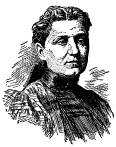 Addams,
Jane - a Chicago woman whose work in the neighborhoods of that city
led to important reforms nationwide in efforts to help the poor.
She is famous for establishing Hull House in 1889 as a kind of
community
center in a slum section of Chicago. It offered advice and
classes
for immigrants trying to adjust to American life, and its success led
to
the creation of settlement houses in other cities. Addams,
Jane - a Chicago woman whose work in the neighborhoods of that city
led to important reforms nationwide in efforts to help the poor.
She is famous for establishing Hull House in 1889 as a kind of
community
center in a slum section of Chicago. It offered advice and
classes
for immigrants trying to adjust to American life, and its success led
to
the creation of settlement houses in other cities.
The settlement house movement drew in and gave a
cause to many educated American women, and helped create a broader
consciousness
of social issues. The movement is an important sign of a shift in
ideas about class and poverty away from Social Darwinism. Now,
the
idea was growing that poverty had social causes that could be studied
and
solved. Addams is often considered "the mother of social work" in
the U.S.
 Anthony,
Susan B. - the most famous of the 19th century women who organized
to fight for woman suffrage (the right to vote). A teacher in
Rochester,
N.Y., she became involved in the movement with Elizabeth Cady Stanton
in
the 1850s. Anthony,
Susan B. - the most famous of the 19th century women who organized
to fight for woman suffrage (the right to vote). A teacher in
Rochester,
N.Y., she became involved in the movement with Elizabeth Cady Stanton
in
the 1850s.
Anthony and a group of other women in Rochester
voted in the 1872 presidential election. She was arrested some
weeks
later, tried, and fined $100. She refused to pay. She
continued
pressing for a constitutional amendment guaranteeing the right of women
to vote, while other groups favored a state-by-state approach.
Anthony
died in 1906, but her work helped bring about the 19th Amendment, which
gave women the right to vote nationwide in 1920.
American Federation of Labor - the most famous of
the
labor unions
that grew in the Gilded Age to fight for better pay and conditions for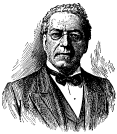 factory
workers. The AF of L was formed in 1881 by Samuel Gompers, a poor
Jewish immigrant who rose to become president of a cigar maker's union
in New York City. factory
workers. The AF of L was formed in 1881 by Samuel Gompers, a poor
Jewish immigrant who rose to become president of a cigar maker's union
in New York City.
The AF of L was actually a federation (association)
of many labor unions, and as such, represents a trend toward "bigness"
similar to what was happening in industry. It included only
skilled
workers, not unskilled workers.
Gompers and the AF of L did not oppose the system
of capitalism and big industry, as some radical labor leaders
did.
He just wanted a better deal for workers, and fought for it until his
death
in the 1920s. The AF of L later merged with the Congress of
Industrial
Organizations to form the AFL-CIO, a powerful union even today.
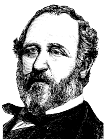 Boss
Tweed - the nickname of William Marcy Tweed, the most famous of the
political bosses who controlled many large American cities in the
Gilded
Age. Tweed was the kingpin of the Democratic Party's "political
machine"
in New York City. The organization was nicknamed Tammany Hall,
after
the building where the party held its meetings. Boss
Tweed - the nickname of William Marcy Tweed, the most famous of the
political bosses who controlled many large American cities in the
Gilded
Age. Tweed was the kingpin of the Democratic Party's "political
machine"
in New York City. The organization was nicknamed Tammany Hall,
after
the building where the party held its meetings.
Tweed and his counterparts in other big cities built
their power mainly on the votes of poor immigrants who needed the small
favors the party organization provided. If necessary, ballot-box
stuffing produced more votes to elect the party's candidates. For
the party members, the pay off of their efforts came in the control of
City Hall money and contracts. This control was used in various
crooked
ways to generate millions of dollars for insiders.
The Tweed ring was broken by newspaper stories about
graft [fraud] and corruption in city politics in 1871, and Tweed
himself landed in jail. But the general pattern of politics he
represented
survived well into the 20th century in many big cities.
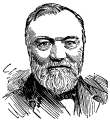 Carnegie,
Andrew - the young Scottish immigrant who rose from a bobbin boy in
a cotton mill to become the owner of America's largest steelmaking
corporation
in the late 1800s. Largely self-educated, Carnegie worked his way
up a series of jobs as America was becoming an industrial giant in the
Gilded Age. Carnegie,
Andrew - the young Scottish immigrant who rose from a bobbin boy in
a cotton mill to become the owner of America's largest steelmaking
corporation
in the late 1800s. Largely self-educated, Carnegie worked his way
up a series of jobs as America was becoming an industrial giant in the
Gilded Age.
He pioneered business practices that are now common,
including very large-scale production, and "rationalizing" the
production
processes. This meant studying every aspect of the process
carefully,
then improving each step of production. (McDonald's, for example,
uses the same approach today with fast food.)
He sold his steel company for $500 million in 1901,
then gave away most of his fortune, much of it to build public
libraries.
He spoke of an obligation of wealthy people to make money, then use it
for the public good. Workers in his plants, however, faced the
same
harsh conditions and long hours that were common in big industry at the
time.
 Dawes
Act - the act passed by Congress in 1887 that tried to
"Americanize"
the Indians by breaking up the tribal system. It failed.
The
law was passed by Congress after most Indian tribes were already
confined
to reservations in the West. Dawes
Act - the act passed by Congress in 1887 that tried to
"Americanize"
the Indians by breaking up the tribal system. It failed.
The
law was passed by Congress after most Indian tribes were already
confined
to reservations in the West.
The Dawes Act represents two conflicting
ideas.
Americans would accept Indians as citizens. But they would not
accept
them as Indians. Under the act, the Native American nations were
declared abolished. Indian families got 160 acres of reservation
land as their own. The idea failed, in part because Indians were
not given farm equipment or taught how to farm.
Today, some Native Americans still live on
reservations,
and try to keep alive tribal traditions. Others live and work in
mainstream American society.
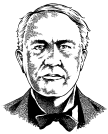 Edison,
Thomas - a famous inventor who created the electric light bulb,
phonograph,
and movie projector in the decades before 1900. Edison is
important
because he represents the birth of a systematic approach to inventing
things.
He held more than a thousand patents. Edison,
Thomas - a famous inventor who created the electric light bulb,
phonograph,
and movie projector in the decades before 1900. Edison is
important
because he represents the birth of a systematic approach to inventing
things.
He held more than a thousand patents.
The electric light (1879) changed the look of
American
cities, and created an entire industry to supply electric power.
Edison's laboratory was in Menlo Park, New Jersey. It ushered in
the modern idea of a “research and development” company. His most
famous saying is that genius is "one percent inspiration, and 99
percent
perspiration."
Ellis Island - the first stop of millions of
immigrants
entering
through New York City from 1892 to 1943. Immigrants arriving
through
Ellis Island were examined for infectious disease and other health
problems
before being allowed to enter the country. It is open today as
a
museum.
graft - the term for corruption in politics that
involves crooked
money making schemes. Often the term is associated with big city
politics, where opportunities for graft are endless for a
well-entrenched
political group or "machine."
A typical scheme might involve rigged bids for road
or construction work. In exchange for a hidden payment or
kickback,
the politicians throw the work - often at an inflated price - to a
company
run by friends. In some cases, the line between graft and a
legitimate
political "donation" can be hard to draw.
Homestead Act - a law passed in 1862 that gave 160
acres of free
land in the West to anyone who would go there and live on the land for
five years.
Some 400,000 families, including thousands of black
settlers, became homesteaders. Home was often made with sod (dirt
and grass) walls, and life was harsh for the early pioneers on the
Great
Plains. Some succeeded, but many found that land without nearby
water
or rail access could never become a successful farm.
Many people preferred buying western land from
railroad
companies. The companies were given the land by the federal
government
along their routes as an incentive to build the lines. Barbed
wire,
the steel windmill (to pump water), and new steel plows were key
inventions
that made farming the Plains possible.
Indian Wars - the
broad term for the sporadic but often deadly battles involving settlers
in the West together with the American Army on one side, and Native
American tribes already living in that region on the other. Some
fighting occured in the decades before the Civil War, but it
intensified as many more settlers headed west after the Civil War ended
in 1865.
political machine - a local or state political
organization that
is so successful at winning elections that its candidates almost always
win. In some cases, this success is due to unfair use of the
political
process to win influence for party insiders. Political machines
are
often headed by a "boss" who dispenses favors of various kinds to keep
the party's members in line and motivated to "get out the vote" at
election
time.
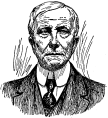 Rockefeller,
John D. - the businessman who started the Standard Oil trust in
1882,
and used it to gain control over most of the nation's oil business in
the
Gilded Age. Rockefeller,
John D. - the businessman who started the Standard Oil trust in
1882,
and used it to gain control over most of the nation's oil business in
the
Gilded Age.
Rockefeller brought organizational genius to a badly
disorganized business. But his methods also included crooked
deals
with railroads and price wars, all designed to drive competitors out of
business. He and his company are often studied today as examples
of business practices of the era. After 1900, courts ordered the
trust broken into separate companies, some of which still exist today.
Rockefeller, like Carnegie, gave away part of his
fortune to worthy projects, such as medical research and the
restoration
of Colonial Williamsburg. Some of his descendants are still
powerful
in banking and other fields.
Sherman Antitrust Act - passed by Congress
in
1890, it
was an early attempt to try to control abuses by large combinations of
businesses called trusts. It generally outlawed combinations of
companies
that acted in restraint of free trade. But it was only rarely
used
against the industrial giants until later laws, like the Clayton Act
(1914),
made it easier to win cases against trusts.
Spanish American War - the war fought in 1898 to
help
Cuba gain
its independence from Spain. The war began after an American
battleship
sent to Cuba, the Maine, mysteriously exploded. But
tension
had already been fanned by American newspapers, all trying to outdo
each
other with reports of Spanish mistreatment of Cubans.
Theodore Roosevelt and his band of volunteers, the
"Rough Riders," became famous in the fight. Victory brought Cuba
under U.S. protection, and outright control of Puerto Rico and the
Philippines.
Filipinos expected to be given their independence. They were not,
however, because America feared that some other country would take them
over. Filipinos launched a rebellion, and American troops were
sent
to keep control of the islands.
At home, the conflict over the Philippines sharply
divided public opinion. Many said it was un-American to use force
to keep the islands. They were finally given their independence
after
World War II.
tenements - a type of apartment building common in
big
cities
starting in the mid 1800s. They were often poorly built and
overcrowded.
Many were created by dividing up floors and even rooms of large
houses.
As a result, not all units had water or toilets. Even in new
tenements,
these facilities were usually in a hallway shared by many families.
In a landmark effort to use government power to
improve social conditions, New York City passed building codes
(1876)
to improve tenements. Jacob Riis exposed the shocking conditions
of life in the tenements in his famous 1890 book, How the Other
Half
Lives.
trusts - a form of business organization in which
several companies
are joined and managed as if they were one giant company. They
are
illegal today, but were common in the late 1800s. To form a
trust,
shareholders of several companies turn over their shares to "trustees"
who manage and coordinate the separate companies. The trust has
more
power to bargain with suppliers and create efficient, large-scale
industries.
It can also avoid the costs of competition.
Consumers, workers, and other competitors, however,
are often hurt. Trusts often became near monopolies, drove
smaller
firms out of business, and “fixed” prices. The Standard Oil trust
is often cited as an example of this pattern. Many trusts also
bribed
politicians to gain special legislation or otherwise benefit their
interests.
The Sherman Antitrust Act (1890) was an early, but
not very successful, attempt to control abusive trusts. After
1900
Congress began passing laws that were more effective, and federal
courts
forced some trusts to split up into separate competing companies.
|
 Addams,
Jane - a Chicago woman whose work in the neighborhoods of that city
led to important reforms nationwide in efforts to help the poor.
She is famous for establishing Hull House in 1889 as a kind of
community
center in a slum section of Chicago. It offered advice and
classes
for immigrants trying to adjust to American life, and its success led
to
the creation of settlement houses in other cities.
Addams,
Jane - a Chicago woman whose work in the neighborhoods of that city
led to important reforms nationwide in efforts to help the poor.
She is famous for establishing Hull House in 1889 as a kind of
community
center in a slum section of Chicago. It offered advice and
classes
for immigrants trying to adjust to American life, and its success led
to
the creation of settlement houses in other cities.